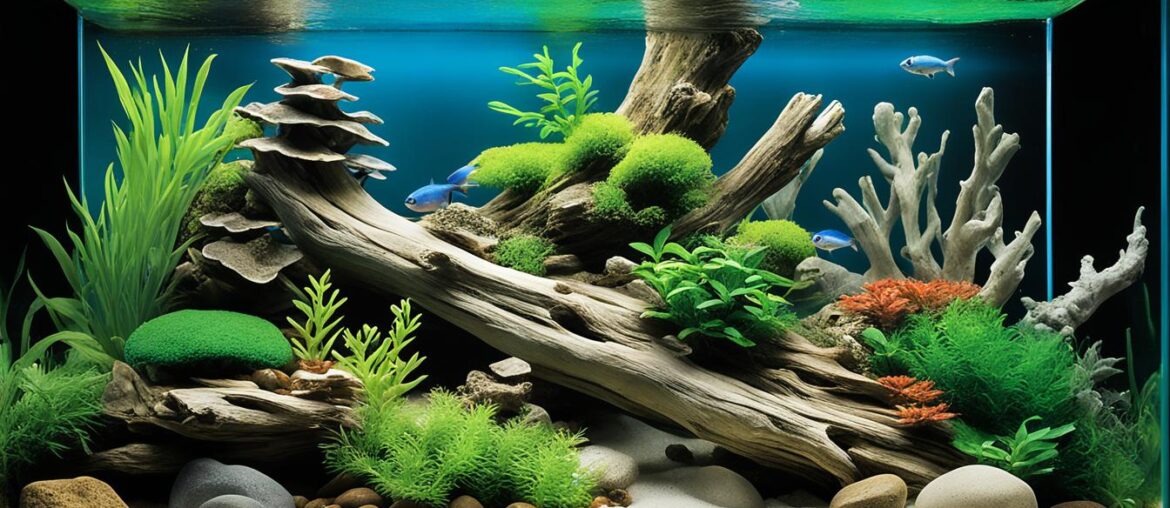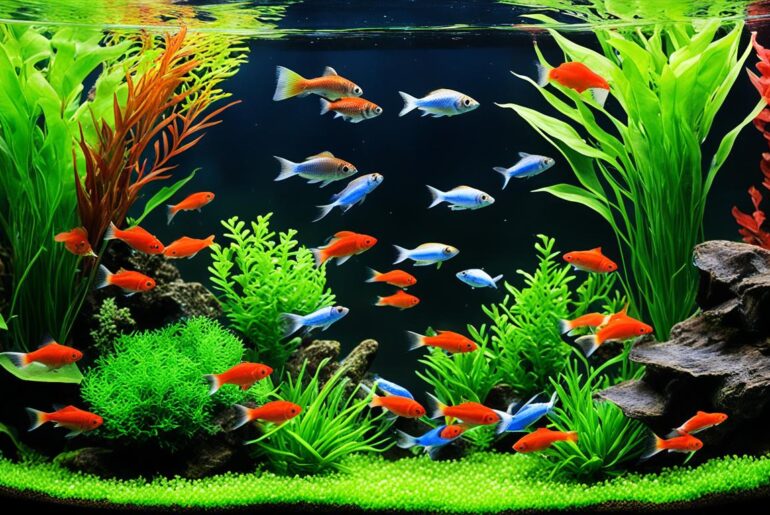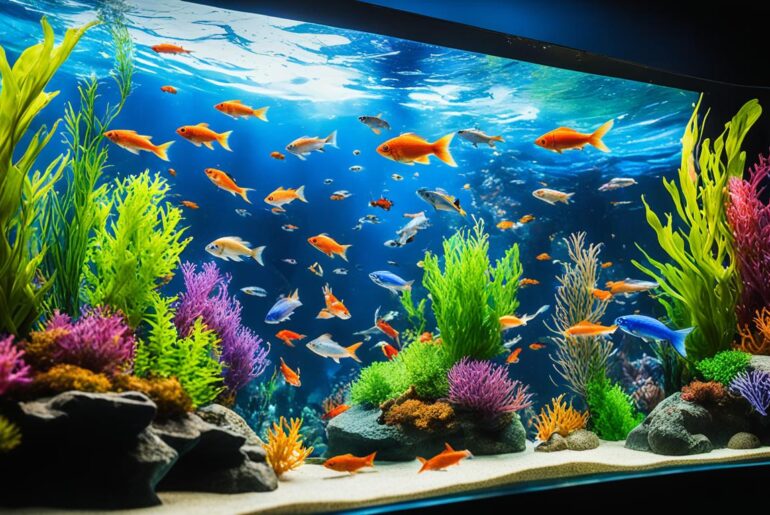Imagine this: you sit in front of your freshwater aquarium, lost in the mesmerizing dance of colorful fish and vibrant aquatic plants. The tank breathes life into your space, creating a serene and captivating environment. It’s a moment of tranquility, a sanctuary where you can escape the chaos of the world.
But what if I told you that there’s something even more magical beneath the surface? Something that not only enhances the aesthetics of your tank but also contributes to the health and well-being of your aquatic ecosystem?
That something is the substrate – the foundation upon which your underwater paradise is built. Choosing the right substrate is like laying the groundwork for a thriving community, providing a stable environment for your fish and aiding in the growth of beautiful aquatic plants.
No two aquariums are the same, and neither are their substrates. The choice depends on various factors, from the size of your tank to the type of fish you plan to keep. So let’s dive into the world of freshwater aquarium substrate choices and explore the options that will transform your tank into a vibrant and natural aquatic haven.
Beginners may feel overwhelmed by the vast array of choices, but fear not! In this article, we’ll break down the different types of aquarium substrates, including freshwater aquarium gravel, sand, aragonite, and more. By understanding their benefits and considerations, you’ll be equipped with the knowledge to make an informed decision that suits your tank and your aquatic companions.
Key Takeaways:
- Choosing the right substrate is crucial for the health and well-being of your freshwater aquarium.
- There are various options available, including gravel, sand, aragonite, and more.
- Each substrate has its own benefits and considerations, so it’s important to choose one that suits your tank and fish species.
- Gravel is a popular choice due to its versatility and ease of maintenance.
- Sand provides a natural look and is favored by fish species that enjoy burrowing or sifting through the substrate.
Gravel – A Popular Choice for Freshwater Aquariums
When it comes to selecting the perfect substrate for your freshwater aquarium, gravel is undoubtedly a top contender. Its versatility, ease of maintenance, and aesthetic appeal make it a favorite among aquarium enthusiasts. With a wide range of sizes, colors, and materials available, gravel allows you to customize your tank’s look to match your preferences.
Gravel is suitable for most fish species, providing a stable surface for them to swim on. However, it’s important to note that certain fish with delicate skin, such as catfish, may benefit more from a smoother substrate like sand. But for the majority of freshwater fish, gravel is an excellent choice.
One of the advantages of gravel is its ability to prevent uneaten food and waste from sinking too deep into the substrate. The particles of gravel create a barrier, allowing for easier cleaning and maintenance of your aquarium. Regular vacuuming of the gravel will help remove any accumulated debris and ensure a clean and healthy environment for your fish.
Aside from its practical benefits, gravel is also an ideal substrate for planted tanks. Its larger particles provide stability, allowing plants to anchor their roots securely. This creates a favorable environment for their growth and ensures they receive the necessary nutrients from the substrate.
If you’re considering adding live plants to your freshwater aquarium, gravel is an excellent option. It provides a natural and aesthetically pleasing backdrop for your plants, enhancing the overall beauty of your tank.
Benefits of Gravel as a Freshwater Aquarium Substrate:
- Customization: Choose from various sizes, colors, and materials.
- Easy Maintenance: Prevents food and waste from sinking too deep, making cleaning easier.
- Stability for Fish: Provides a stable surface for fish to swim on.
- Secure Plant Anchoring: Enables plants to anchor their roots securely.
- Aesthetically Pleasing: Adds a natural and visually appealing element to your aquarium.
Next, we’ll explore another popular substrate choice for freshwater aquariums: soil.
Soil – Ideal for Plant Growth in Freshwater Tanks
Aquarium soil is specifically formulated to stay solid in water and provide essential nutrients for plant growth. It is an excellent choice for those who want to create lush, planted tanks. The soil comes in natural brown colors and is best used as a bottom layer with other decorative substrates on top.
Unlike regular soil found in your backyard, aquarium soil is safe for your fish and prevents the growth of harmful bacteria and toxins. It promotes healthy root development and supports vibrant plant growth, creating a thriving ecosystem within your freshwater tank.
I chose aquarium soil for my planted tank, and the results have been incredible! The plants are thriving, and the colors have become even more vibrant. It’s truly a sight to behold.
In addition to providing nutrients, aquarium soil also helps maintain proper water chemistry and stability. It acts as a natural buffer, preventing significant fluctuations in pH levels and ensuring a stable environment for your aquatic plants and fish.
The Benefits of Using Aquarium Soil:
- Provides essential nutrients for plant growth
- Supports healthy root development
- Promotes vibrant and lush aquatic plants
- Prevents the growth of harmful bacteria and toxins
- Acts as a natural buffer, maintaining water chemistry
When using aquarium soil, it is essential to choose products from reputable brands to ensure the health and well-being of your aquatic plants.
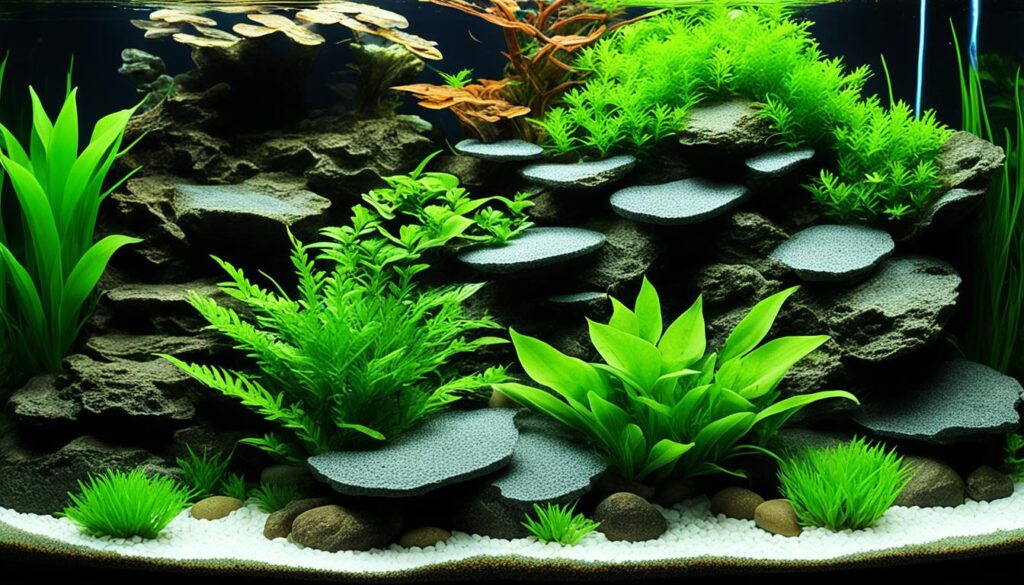
With the right choice of substrate, such as freshwater aquarium soil, you can create a stunning underwater garden in your tank. The combination of fertile soil, vibrant plants, and happy fish will transform your aquarium into a captivating and natural underwater paradise.
Sand – Natural and Easy to Clean Substrate
When it comes to freshwater aquarium substrates, sand is a top choice for many aquarists. Known for its natural and aesthetic appeal, sand offers a range of benefits that make it a popular option. With various grain sizes and colors available, sand allows aquarists to create unique and visually appealing tank setups. Whether you have a community tank or specialize in specific fish species, sand can provide a beautiful backdrop for your underwater habitat.
One of the advantages of using sand as a substrate is its suitability for fish species that enjoy burrowing or sifting through the substrate. For these fish, sand provides a natural and comfortable environment, allowing them to engage in their natural behaviors. Sand is also easy to clean, as debris and waste do not get trapped between the sand particles. This makes maintenance more convenient and ensures a cleaner and healthier tank for your fish.
It is important to note that fine sand may compact more quickly than coarser varieties. This means that fine sand may require more frequent maintenance to prevent compaction and maintain a healthy substrate. However, the regular upkeep is worth it for many aquarists who appreciate the natural look and feel of sand in their tanks.
When choosing sand for your freshwater aquarium, it is crucial to select sand specifically designed for aquarium use. Not all types of sand are suitable for fish tanks, as certain sands may contain harmful chemicals or minerals that can be toxic to your fish. Choosing aquarium-specific sand ensures the safety and well-being of your aquatic pets.
Aquarium Sand vs Gravel: A Comparison
To help you make an informed decision about the best substrate for your freshwater aquarium, here is a quick comparison between sand and gravel:
| Aquarium Sand | Freshwater Aquarium Gravel |
|---|---|
| Offers a natural and aesthetic appeal | Provides a stable surface for fish to swim on |
| Suitable for fish species that enjoy burrowing or sifting | Does not compact as easily as fine sand |
| Easy to clean, with debris and waste not getting trapped | Easier to maintain due to less frequent compaction |
| Requires sand specifically designed for aquarium use | Offers more variety in terms of colors and sizes |
As you can see, both sand and gravel have their own advantages and considerations. The choice between the two ultimately depends on your fish species, tank setup, and personal preference.
Aragonite – Suitable for Maintaining pH Levels
When it comes to maintaining a stable pH level in your freshwater aquarium, aragonite substrate can be a great solution. Made of calcium carbonate, this type of sand slowly releases minerals into the water, helping to regulate the pH level over time. While aragonite is commonly used in reef aquariums, it can also be beneficial for freshwater tanks, especially for fish species that prefer higher pH levels.
However, it’s important to note that aragonite can impact the pH level significantly if not monitored and controlled properly. Excessive pH levels can be harmful to certain fish species. Therefore, regular testing and adjustments are necessary to ensure a healthy and suitable environment for your aquatic pets.
If you decide to use aragonite substrate in your aquarium, there are a few options you can consider. Aragonite can be mixed with other substrates, such as gravel or sand, to create a customized blend that suits your tank’s specific needs. Alternatively, you can use aragonite as the sole substrate in your aquarium, depending on the preferences of your fish and the specific requirements of your setup.
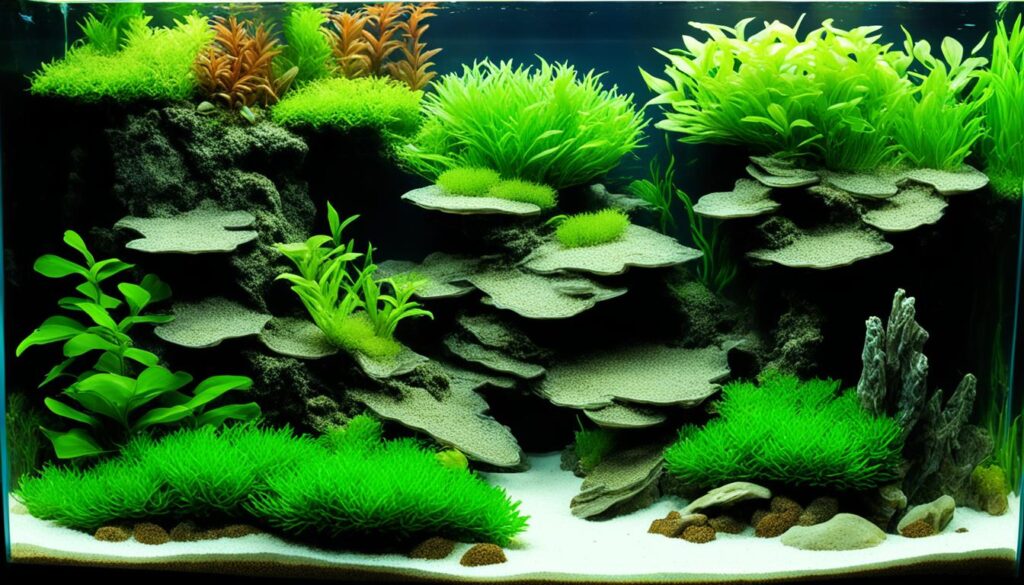
By choosing aragonite as your substrate, you can create a visually appealing freshwater aquarium while also providing a suitable environment for fish species that thrive in higher pH levels.
Vermiculite – Ideal for Plant Growth and Nutrient Release
Vermiculite is a highly beneficial substrate for freshwater aquariums, especially for those with a focus on plant growth and nutrient release. Its unique composition, consisting of various minerals, makes it an excellent choice for supporting the thriving growth of aquatic plants.
One of the primary advantages of using vermiculite as a plant substrate is its gradual release of essential nutrients like potassium and magnesium. These nutrients are crucial for the health and development of aquatic plants, promoting robust root systems and lush foliage.
To maximize the benefits of vermiculite, it is recommended to combine it with gravel in your aquarium setup. This combination creates a nutrient-rich layer that encourages plants to anchor their roots effectively, providing them with ample nutrients for sustained growth.
For plant enthusiasts seeking to establish a vibrant and flourishing planted aquarium, vermiculite serves as an ideal option. Its unique characteristics contribute to creating an aquatic environment that encourages optimal plant growth, resulting in a visually stunning and thriving ecosystem.
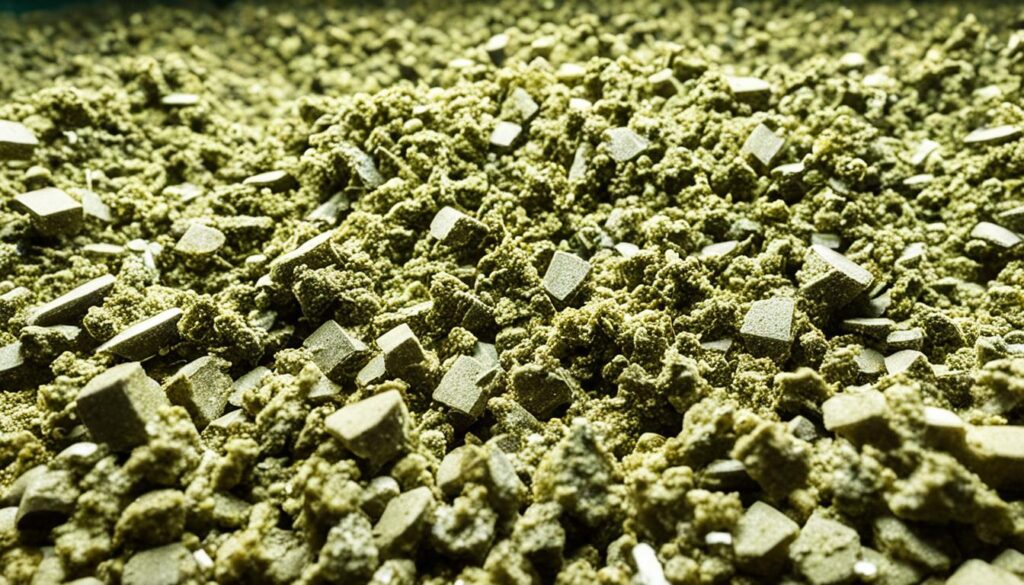
Benefits of Vermiculite as a Plant Substrate:
- Nutrient-rich composition for optimal plant growth
- Gradual release of potassium and magnesium
- Supports the development of robust root systems
- Encourages lush foliage in aquatic plants
- Works best when combined with gravel
Incorporating vermiculite into your freshwater aquarium substrate can create a beautiful and thriving planted tank, providing your aquatic plants with the essential nutrients they need to flourish.
Peat Moss – Natural Water Buffer and Softener
When it comes to creating the ideal water conditions for your freshwater aquarium, peat moss can be a valuable tool. Peat moss is a natural substrate that acts as a water buffer and softener, providing a comfortable environment for fish species that require softer water conditions.
Using peat moss in your aquarium can help recreate the natural habitat of many fish species, promoting their overall well-being. It is especially beneficial for keeping and breeding fish that thrive in acidic or soft water, such as tetras, angelfish, or Discus.
Before using peat moss in your aquarium, it is essential to ensure that it is free from fertilizers or chemicals that could harm your fish. To prepare the peat moss for use, soak it in a plastic bag filled with water for a few days. This process helps balance the pH levels and removes any potential toxins, ensuring a safe and healthy environment for your fish.
Peat moss can be spread as a substrate layer in your aquarium or used as a filter medium to achieve the desired water parameters. It slowly releases tannins and organic acids, creating a natural softening effect and lowering the pH of the water. Additionally, peat moss helps to naturally reduce the carbonate hardness (KH) of the water, which can be beneficial for certain fish species.
It’s important to note that while peat moss can be highly effective in maintaining optimal water conditions, its effects are not permanent. Over time, the peat moss will become exhausted and lose its buffering capabilities. Regular monitoring and maintenance are required to ensure that the desired water parameters are consistently maintained.
Benefits of Using Peat Moss in Your Freshwater Aquarium:
- Creates a natural softening effect and lowers pH levels
- Reduces carbonate hardness (KH)
- Recreates the natural habitat for fish species that require softer water
- Promotes the well-being and breeding of fish that thrive in acidic water conditions
- Helps create a comfortable and stress-free environment for your fish
Tips for Using Peat Moss:
- Source high-quality peat moss from reputable suppliers to ensure its purity
- Soak the peat moss in a plastic bag filled with water for a few days before use to balance pH levels and remove toxins
- Add the soaked peat moss as a substrate layer or use it in a filter medium
- Monitor and test water parameters regularly to maintain the desired conditions
- Replace the peat moss as needed to ensure consistent water buffering effects
Incorporating peat moss into your freshwater aquarium can help create a natural and comfortable environment for your fish. By using this natural water buffer and softener, you can provide the optimal conditions for fish species that thrive in softer water, promoting their overall health and well-being.
| Advantages of Using Peat Moss in Your Freshwater Aquarium | Disadvantages of Using Peat Moss in Your Freshwater Aquarium |
|---|---|
| 1. Creates a natural softening effect and lowers pH levels | 1. Effects are not permanent and require regular maintenance |
| 2. Reduces carbonate hardness (KH) | 2. Some fish species may not tolerate softened water |
| 3. Recreates the natural habitat for fish species that require softer water | 3. Peat moss may discolor the water, creating a tea-like appearance |
| 4. Promotes the well-being and breeding of fish that thrive in acidic water conditions | 4. Can be difficult to adjust and control pH levels precisely |
| 5. Helps create a comfortable and stress-free environment for your fish | 5. Requires careful monitoring and testing of water parameters |
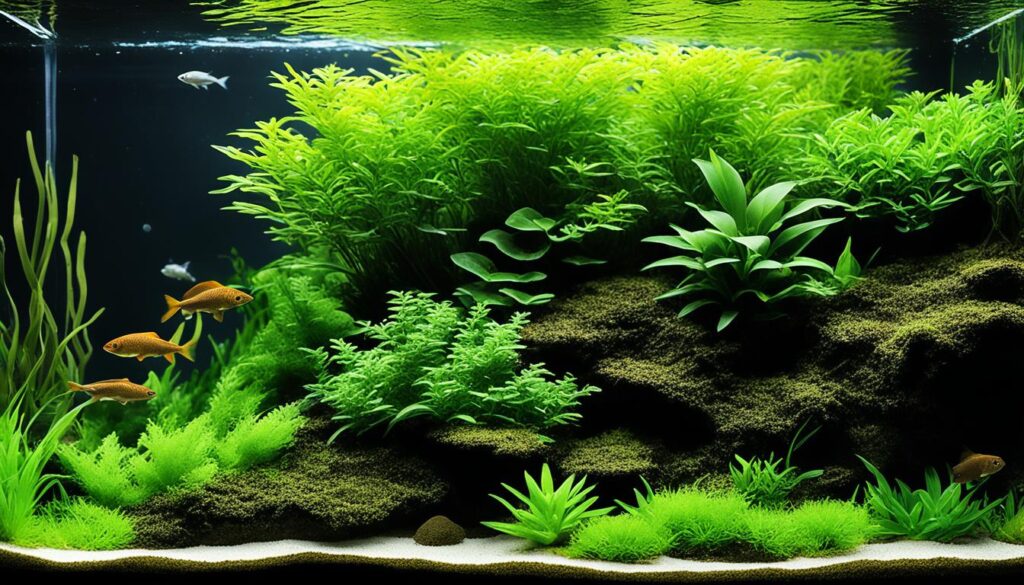
Coral – pH Stabilizer and Favorite of African Cichlids
When it comes to maintaining stable pH levels in aquariums, crushed corals are a go-to choice for many aquarists, especially in reef setups. These corals not only help stabilize the pH but also provide a natural habitat for various fish species, creating a captivating underwater environment.
The alkalizing properties of crushed corals make them particularly favored by freshwater African cichlids, as they thrive in hard water conditions. These vibrant and colorful fish species require specific water parameters to flourish, and crushed corals help meet their needs.
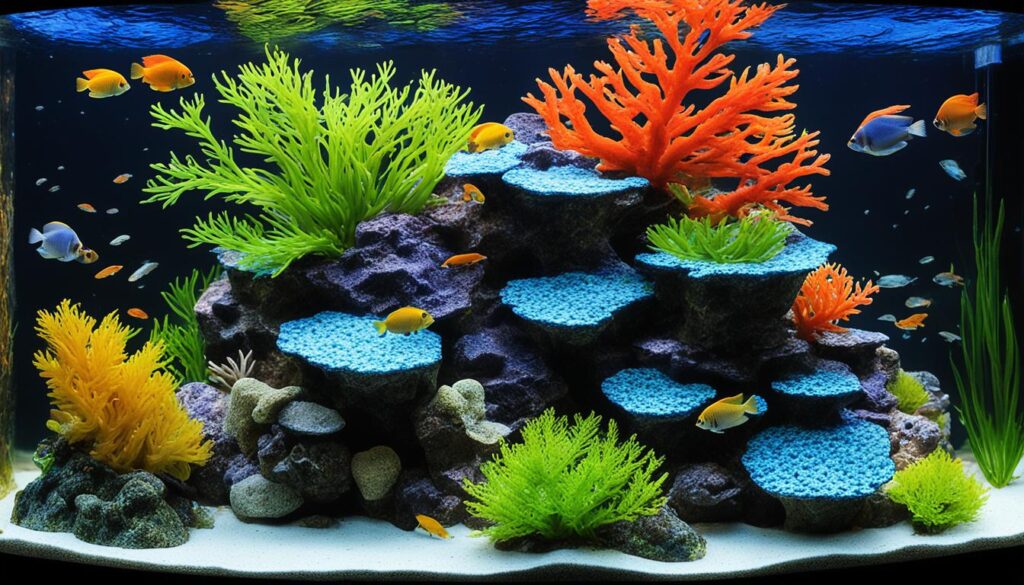
In addition to their usefulness in African cichlid tanks, crushed corals can also be utilized in planted aquariums. However, it is important to monitor the pH levels regularly to prevent them from becoming too high, as some plants may not thrive in excessively alkaline conditions.
“Crushed corals are a versatile substrate choice for both experienced and beginner aquarists. They offer an easy way to stabilize pH levels while providing a visually appealing and natural-looking substrate.”
Crushed corals are readily available at pet stores, making them easily accessible for aquarists of all levels of expertise. Their suitability for different types of aquariums, from African cichlid tanks to planted setups, makes crushed corals a popular choice in the freshwater aquarium hobby.
Conclusion
When it comes to selecting the right substrate for your freshwater aquarium, there are plenty of options to consider. It’s important to evaluate the needs of your fish, the size of your tank, and the desired aesthetic before making a decision.
Gravel is a versatile choice that suits most fish species and is particularly well-suited for planted tanks. It provides stability for fish to swim on and prevents debris from sinking too deep into the substrate.
If you’re aiming for lush, thriving aquatic plants, soil is an excellent option. It offers essential nutrients for plant growth and can be layered with other decorative substrates for added visual appeal.
For a natural look and easy maintenance, sand is an attractive choice. Its fine particles make it ideal for fish species that enjoy burrowing or sifting through the substrate.
Aragonite is beneficial for maintaining pH levels, while vermiculite promotes nutrient release for plants. Peat moss and coral act as natural water buffers, and marbles and clay have specific uses and considerations. Understanding the characteristics of each substrate will help you create a healthy and visually stunning freshwater aquarium.
FAQ
What is the best substrate for a freshwater aquarium?
There are several excellent substrate options for freshwater aquariums, including gravel, soil, sand, aragonite, vermiculite, peat moss, coral, marbles, and clay. The best choice will depend on factors such as the size of your tank and the type of fish you plan to keep.
Can I use gravel as a substrate for a planted tank?
Yes, gravel is a popular choice for planted tanks. Its particles provide a stable surface for plants to anchor their roots, allowing them to grow and thrive. Gravel also makes maintenance easier by preventing uneaten food and waste from sinking too deep into the substrate.
Is sand a good substrate for freshwater aquariums?
Yes, sand is a natural and aesthetically pleasing substrate option for freshwater aquariums. It is easy to clean as debris and waste do not get trapped between the sand particles. Sand is particularly suitable for fish species that enjoy burrowing or sifting through the substrate.
What is the purpose of using aragonite as a substrate?
Aragonite is a type of sand that slowly releases calcium carbonate into the water, helping to maintain a stable pH level. It is often used in reef aquariums but can also be used in freshwater tanks for fish species that prefer higher pH levels. It is important to monitor and control the pH when using aragonite.
How does vermiculite benefit aquatic plants in a freshwater aquarium?
Vermiculite is a substrate that contains a mixture of different minerals, making it beneficial for plant growth. It gradually releases potassium and magnesium, providing essential nutrients for aquatic plants. Vermiculite works best when combined with gravel, creating a nutrient-rich layer for plants to anchor their roots.
Can I use peat moss to soften the water in my freshwater aquarium?
Yes, peat moss is a natural substrate that can be used to buffer and soften aquarium water. It is particularly useful for fish species that require softer water conditions. However, it is important to ensure that the peat moss does not contain any fertilizers or chemicals that could harm your fish.
Is coral a suitable substrate for freshwater aquariums?
Crushed corals can be used as a substrate in freshwater aquariums. They are commonly used to stabilize pH levels in reef setups and provide a natural habitat for different fish species. Crushed corals are particularly favored by freshwater African cichlids, as they prefer hard water conditions.
How do I choose the right substrate for my freshwater aquarium?
When choosing a substrate for your freshwater aquarium, consider the needs of your fish, the size of your tank, and the desired aesthetic. Research different substrates and their benefits, and select one that is compatible with your fish and plant species. Additionally, consider factors like ease of maintenance and water parameter requirements.
